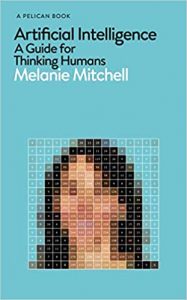There are several good introductions to AI; the three I’ve read complement each other well. Hannah Fry’s Hello World is probably the best place for a complete beginner to start. As I said in reviewing it, it’s a very balanced introduction. Another is Pedro Domingo’s The Master Algorithm, which is more about how machine learning systems work, with a historical perspective covering different approaches, and a hypothesis that in the end they will merge into one unified approach. I liked it too, but it’s a denser read.
Now I’ve read a third, Melanie Mitchell’s Artificial Intelligence: A Guide for Thinking Humans.  It gives a somewhat different perspective by describing wonderfully clearly how different AI applications actually work, and hence helps understand their strengths and limitations. I would say these are the most illuminating simple yet meaningful explanations I’ve read of – for example – reinforcement learning, convolutional neural networks, word vectors etc.I wish I’d had this book when I first started reading some of the AI literature.
It gives a somewhat different perspective by describing wonderfully clearly how different AI applications actually work, and hence helps understand their strengths and limitations. I would say these are the most illuminating simple yet meaningful explanations I’ve read of – for example – reinforcement learning, convolutional neural networks, word vectors etc.I wish I’d had this book when I first started reading some of the AI literature.
One thing that jumps out from the crystal clear explanations is how dependent machine learning systems are on humans – from the many who spend hours tagging images to the super-skilled ‘alchemists’ who are able to build and tune sophisticated applications: “Often it takes a kind of cabbalistic knowledge that students of machine learning gain both from their apprenticeships and from hard-won experience.”
The book starts with AI history and background, then covers image recognition and similar applications. It moves on to issues of ethics and trust, and then natural language processing and translation. The final section addresses the question of whether artificial general intelligence will ever be possible, how AI relates to knowledge and to consciousness. These are open questions though I lean toward the view – as Mitchell does – that there is something important about embodiment for understanding in the sense that we humans mean it. Mitchell argues that deep learning is currently hitting a ‘barrier of meaning’, while being superb at narrowly defined tasks of a certain kind. “Only the right kind of machine – one that is embodied and active in the world – would have human level intelligence in its reach. … after grappling with AI for many years, I am finding the embodiment hypothesis increasingly compelling.”
The book then ends with brief reflections on a series of questions – when will self-driving cars be common, will robots take all the jobs, what are the big problems left to solve in AI.
Together, the three books complement each other and stand as an excellent introduction to AI, cutting through both the hype and the scary myths, explaining what the term covers and how the different approaches work, and raising some key questions we will all need to be thinking about in the years ahead. The AI community is well-served by these thoughtful communicators. A newcomer to the literature could read these three and be more than well-enough informed; my recommended order would be Fry, Mitchell, Domingo. Others may know of better books of course – if so, please do comment & I’ll add an update.
UPDATE
The good folks on Twitter have recommended the following:
Human Compatible by Stuart Russell (I briefly forgot how much I enjoyed this.)
Rebooting AI by Gary Marcus
Parallel Distributed Processing by David Rummelhart & others (looks technical….)
The Creativity Code by Marcus Du Sautoy
Machine, Platform, Crowd by Andrew McAfee Erik Brynjolfsson (also reviewed on this blog)
AI: A Modern Approach by Stuart Russell and Peter Norvig (a key textbook)
